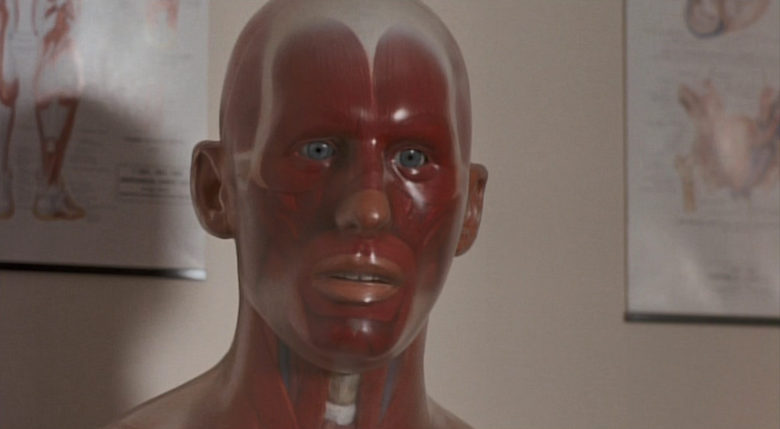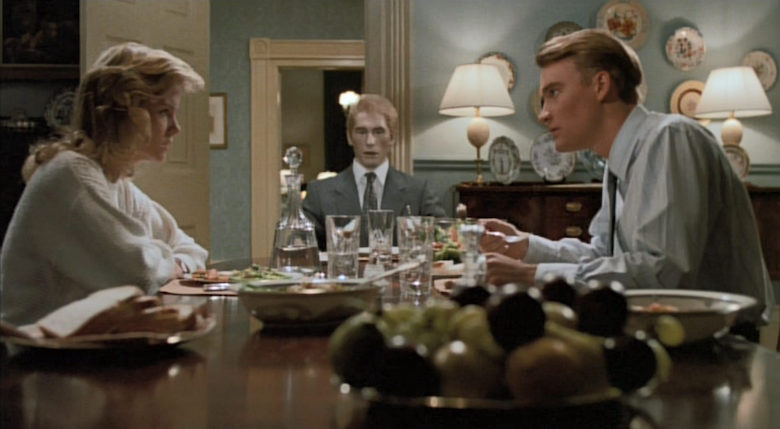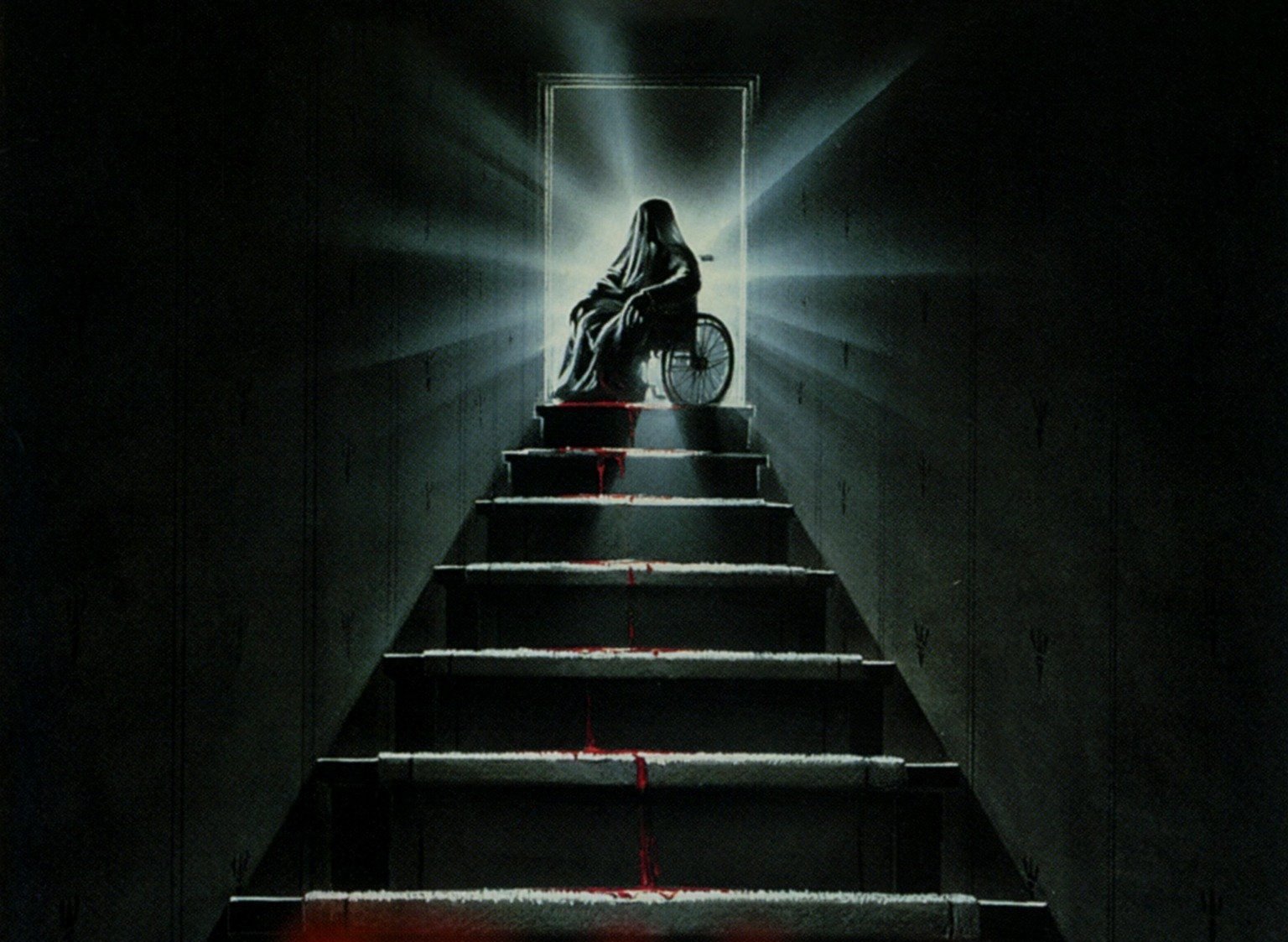In 1981 horror novelist Andrew Neiderman published the book Pin. The book is described as a waspy gothic drama with incestuous possibilities, dark themes that resonated with fans of fellow horror novelist V.C. Andrews.
It’s only fitting that Neiderman became her official ghost writer after her passing in 1986. To date he has penned over 85 novels for Andrews while continuing to publish under his own name. The novel Pin was passed to Canadian doctor turned horror director Sandor Stern. He found Neiderman’s characters tragically alluring. Especially the story’s focal point, a medical office’s anatomical dummy. With Neiderman consulting, Stern adapted the book into a screenplay. But it would be another 5 years before directing the movie Pin for New World pictures.
Pin: A Plastic Nightmare
Brother and sister Leon and Ursula grow up in a life of luxury and emotional repression. Mother hovers over her children with a vacuum and dustpan. Strict and sterile, furniture covered in plastic and crisp white clothes.
The wealthy Dr. Linden is their father, cold and buried in his work. In his private practice, he keeps a life-sized anatomical model. A visible man named “Pinocchio” or Pin for short.

Using ventriloquism, Dr. Linden converses with Pin to entertain younger patients and educate his children. Leon and Ursula learn the facts of life as explained by Pin, with warmth and affection… the emotional qualities that Dr. Linden denies his own son and daughter.
Pin becomes a parental surrogate, always thoughtful and knowing just the right thing to say, offering gentle words of advice to comfort the friendless siblings.
Ursula discovers Dr. Linden’s illusion early on, but her brother believes Pin is truly alive. Leon even begins sneaking into his father’s office to beg Pin for conversation. But the endearing fantasy becomes awkward and unnatural with age, awakening a sinister gaze from the medical dummy’s plastic eyes.

Pin suddenly seems to be everywhere and answering Leon’s requests for advice, even when Dr. Linden isn’t around. Meddling in relationships and putting ideas in Leon’s head. Unlike Pinocchio, Pin’s nose never grows because he never tells a lie. Everything he does is in the best interest of the Linden siblings. He is a member of the family, after all.
David Hewlett plays the often-guileless Leon as an adult. Hewlett is recognizable from other sci-fi thrillers like Splice, Cube, and Scanners II: The New Order. Cynthia Preston is the beautiful Ursula, having previously starred in the 1999 television series Total Recall 2070 as Olivia Hume. Dr. Linden is played by Terry O’Quinn, a favorite to horror fans as the sinister Jerry Blake in The Stepfather and Stepfather II: Make Room For Daddy. Character actor Jonathan Banks lends his voice to Pin. Going from the gruff figure he’s best known as in Breaking Bad and Better Call Saul, to the calm and inanimate titular villain. Writer and director of the movie Pin, Sandor Stern, is best known as writer of the original screenplay for 1979’s The Amityville Horror. He had even adapted Duplicates, another Neiderman novel, as a made-for-tv sci-fi thriller.
By the time the movie Pin had finished shooting and editing, New World had dissolved their feature films division. The Roger Corman company had intended to release it as one of their last films but decided against it, last minute. Sandor Stern had to travel to San Francisco for a delayed postproduction, where the first screening flopped at Century City. Not wanting to put any more money into it, New World released Pin direct-to-video in January of 1989.
As with all good films with rotten luck in distribution, the movie Pin (or alternative title Pin: A Plastic Nightmare) slowly gained a cult following. In December of 1991, a print had found its way to the Manhattan Film Forum for a two-week run. Receiving excellent reviews, Pin was picked up for another two-week run in a San Francisco art house theater. Critics raved that Pin was severely overlooked when it comes to split personality horror films. Sharing the familial repression of Hitchcock’s Psycho and slasher thrills in 1978’s Magic. Themes of grief and identity loss can also be seen in the ventriloquist drama, The Great Gabbo.
“I have never lied to you or for you.”
In early 2011, Bloody Disgusting confirmed that Sandor Stern would be returning to direct a remake of the movie Pin. Andrew Neiderman had retained the original rights and together they set to rewrite a script closer to the novel, updated and with more horror elements but no interest in a plain re-do.
— FOUNDATIONS OF HORROR —
Further explore these subgenres & tropes. more>>
#Psychological horror | #Losing Your Sanity is Crazy

Writer Jack Reher reached out to Neiderman and Stern begging to pen the first draft. Reher was a long-time fan of the movie Pin and novel and claimed a re-imagining was his passion. Unfortunately for him, Stern and Neiderman hated it and told Reher to forget the whole thing. A few years later, producers were contacting the men about wanting to do this movie, discovering that Jack Reher had been fanning a script around on social media without permissions or rights. In an interview with Flickering Myth, Reher assured fans that the remake would elevate the movie with Nicholas Bogner scheduled to direct. After a few cease-and-desist letters, Reher gave up on the remake and seems to have reinvented himself a few times since then.
Though largely unknown and overlooked as another early 90’s video store slasher, the movie Pin remains a favorite. Highly regarded as a psychological horror gem, genuinely disturbing and twisted. The audience will find themselves sympathizing with every tortured character throughout their lives. Each scene is a puzzle piece that makes up a larger motion picture that sticks with you.
Last Updated on September 7, 2021.

